Four kinds of accidents in Hearthstone
The Hearthstone: Heroes of Warcraft collectible card game is a popular online entertainment and one of the major cyber disciplines. In the new post “Management of online gaming projects” we publish a translation of the article by game designer Ubisoft Stanislav Kostyuk about the role of different types of accidents in this game and about their emotional impact on players.
In card games, including collectible games, there is always a place for randomness, if only because the deck in each game is shuffled and the players do not know in what order they will draw their cards. Hearthstone, being a completely digital game, tries to avoid such an impact of accidents on the game process. Some people like these experiments, others don't. But let's take a look at the different types of randomness in Hearthstone and how they are perceived by players from a design point of view.
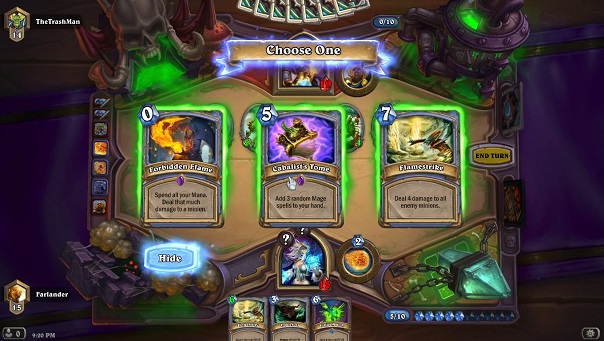
This type of accidents is recognized by players as the most fair. Of course, some may be very lucky, but all this is possible to predict and cope with this. A very good example of cards with strategic randomness is Shaman spells with varying damage, for example, Thunderstorm (Lightning Storm). A thunderstorm deals 2-3 points of damage to all enemy creatures, and the damage value for each creature is determined separately.
')

So, you play against the Shaman: knowing exactly that he is able to use the Thunderstorm to “clean up” the table, you can take a risk and put on the table a bunch of creatures with three health units, relying on the probability of survival of at least a few of them, if spell. The Shaman himself can also increase his chances of success, either by relying on luck, or by using the ability to summon a Wrath of Air Totem (giving +1 to spell damage), or by playing a card that gives a bonus to damage.

Strategic chance determines a small number of possible outcomes. This means that both players can easily calculate options. Therefore, most consider this type of randomness to be honest, even if they are not lucky in it.
Acceptable randomness occurs when a fairly large number of outcomes, but the number is small enough to miscalculate options, or the options are logically simply discarded. In terms of gameplay, the best example is the contents of the deck of the player and his opponent. The player knows exactly what he plays with thirty cards, so each drawn card reduces the number of possible outcomes, i.e. the probability of drawing a specific card increases over time.
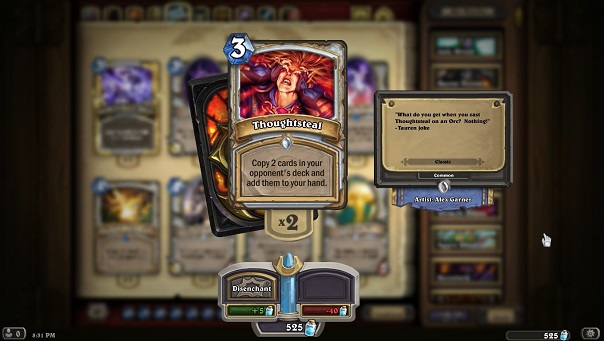
Also, the following can be cited as an example: the enemy can have a set of 400 cards available to him (more when playing in the Wild mode, where all the card sets are open), but with each card played by him the player based on his thoughts on the collected The opponent deck can eliminate a multitude of probabilities. For example, it is unlikely that the aggressive zoo-deck, which is based on the principle of attack by a bunch of small creatures, will contain Deathwing. It is worth noting that once I added Deathwing to my Zoo-deck of Warlock (Warlock), and the opponents did not expect it at all. It was a pleasure to use it. On the other hand, he did not fit well with the rest of the deck, so most of the time he was hanging on his hands as a dead weight.
Specific good examples of cards with a random effect can serve such spells as Stolen Thoughts (Thoughtsteal), which copies 2 cards from the deck of the enemy. When you play against stolen thoughts, you understand what you may encounter, because you know your deck. And if you cast the Stolen Thoughts spell, then it helps you understand the archetype of the opponent’s deck.

Another good example is some maps with excavation mechanics, for example, Ethereal Conjurer. Excavations allow you to get in your hands one of the three variants of maps randomly selected from a certain pool (depending on the map). The Ethereal Enchanter is a Mage card that unlocks spells. Therefore, if your opponent plays it, you can figure out the worst and best scenarios and take action against them.
So, although the opponent’s good fortune can be quite annoying, usually players are not angry with this type of randomness, because they can still logically calculate the possible outcomes
And here everything becomes more complicated. Double edged accident occurs in cases where its effect can be average, very good for the player, or very bad for the player. The reason for the difficulty is that a diametrically different emotional impact on the players can have a single effect. If the result of the effect is very good for the player, his opponent becomes angry or annoyed while the player is happy, and vice versa.
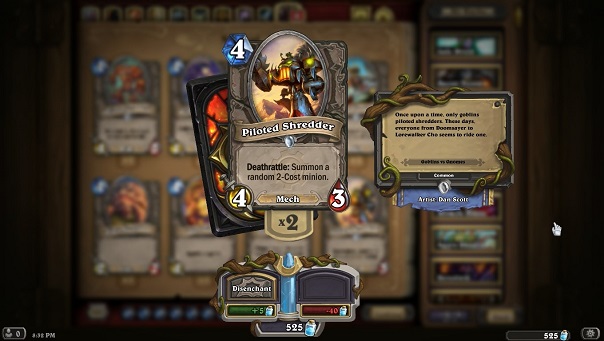
A great example of this type of card is the Piloted Shredder. This creature is worth 4 mana points, after its death it causes a random creature costing 2 mana points. At the time of the release of the Goblins and Dwarfs set (Goblins vs Gnomes), this card was almost automatically added to each deck. Not only because on average the resulting creature was quite good, but also because there was a fairly high probability of summoning a creature with the best two-point creatures - the legendary Millhouse Manastorm (strength and health: 4/4). He has an unprofitable battle cry, but very good performance, this was the meaning of the Manned Crusher. However, there were fairly high chances of calling the Herald Rock (Doomsayer), which could be either very useful or interfering, depending on whether you controlled the table or not. It was also likely to cause a very weak creature.
An interesting side effect of the Piloted Shredder type of cards is that over time they became weaker and weaker. This card is extremely strong when you can choose only one of 65 creatures, but now it participates only in the Free mode, in which there are already more than 100 possible creatures at the cost of 2 mana points. Therefore, it is not automatically added to the deck. However, this is still a good card, especially in the N'zoth deck, and it will never drop to the level of a “bad” card, although not so powerful anymore.
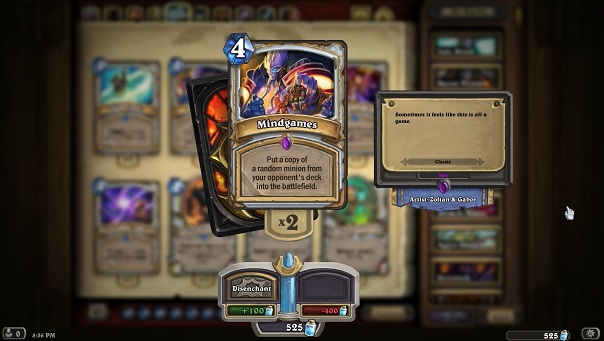
A more stable example of this type of randomness can be the Mind Games of the Priest (Priest) or the Call of the Ancestors (Ancestor's Call) of the Shaman. A mind game triggers a random creature from the opponent’s deck. Depending on the type of creature, this card can lead to a winning or losing party, because you get 1/1 for 4 mana points and lose your turn. The situation is similar with the Call of ancestors spell, depending on the type of creatures that it puts on both hands.
This is the most controversial kind of chance. The reason is not only that it has a strong emotional effect, but also that it is really impossible to think out a strategy against it.
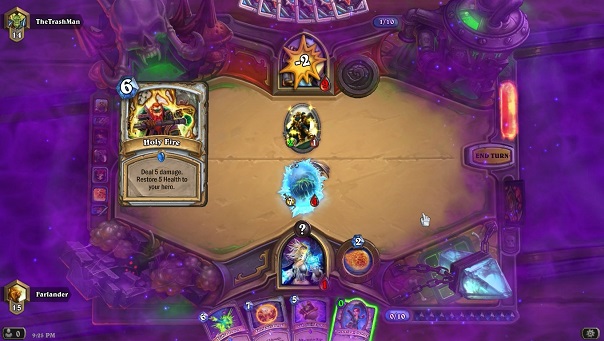
The most obvious example of such an accident is the Yogg-Saron type map. The player utters a sufficient number of spells, puts Yogga, and then the unpredictable happens. Honestly, Yogg in particular is very fun for both players, regardless of whose life he ruins, simply because of the ridiculousness of the possible effect.
But there are much more one-sided cards. For example, after the release of the set “Mean Streets of Gadgetzan”, each class has a map in the spirit of the excavation map of Magus, Priest or Warlock. Therefore, the pool in the Standard mode for this kind of randomness is about 200 cards. And although from the point of view of statistics, this is not an unbalanced action, but when this card is played against a player, he can’t figure out what kind of card it will be. It may be something logical, or a legendary, or very strong map of another class, which is completely impossible to predict. When a player creates his deck or plays against an opponent, he does not expect the Priest to become Jaraxus (Jaraxxus) or that the Warlock will pull Antonidas (Antonidas) and the Magician - Mind Control (Mind Control). And when this happens, neither victory nor defeat can teach the player anything new.
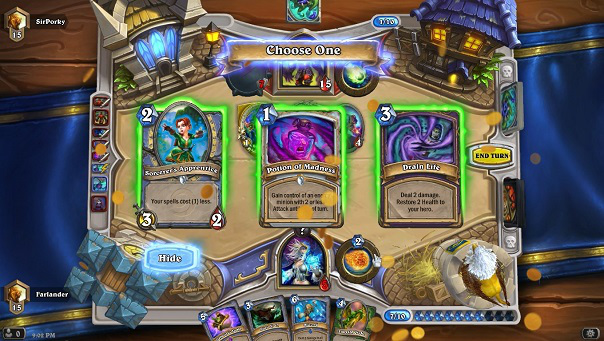
So, in Hearthstone there are four main types of accidents. I think that many readers expect me to call the first two good and the rest bad. But in this case, none of them can be considered bad. They are just different.
In fact, I wanted to say that in a competitive environment, strategic and acceptable accidents are valued much higher. Therefore, people with a competitive mindset can be annoyed by the maps of the last two types. However, double-edged and absolute coincidences can create unforgettable stories that are interesting to tell others, and I would not want such a gaming experience to be removed from Hearthstone.
But it still does not mean that in every card game there should be the same types of accidents. It all depends on the sensations you want to create. In general, I believe that Hearthstone does a good job at balancing all these types of random effects.
Subscribe to our blog, new interesting articles on gamedev are waiting for you. And if you want to not only read, but also listen, then come to our open lectures in Moscow. Login is just by registering here:
In card games, including collectible games, there is always a place for randomness, if only because the deck in each game is shuffled and the players do not know in what order they will draw their cards. Hearthstone, being a completely digital game, tries to avoid such an impact of accidents on the game process. Some people like these experiments, others don't. But let's take a look at the different types of randomness in Hearthstone and how they are perceived by players from a design point of view.

Strategic chance
This type of accidents is recognized by players as the most fair. Of course, some may be very lucky, but all this is possible to predict and cope with this. A very good example of cards with strategic randomness is Shaman spells with varying damage, for example, Thunderstorm (Lightning Storm). A thunderstorm deals 2-3 points of damage to all enemy creatures, and the damage value for each creature is determined separately.
')

So, you play against the Shaman: knowing exactly that he is able to use the Thunderstorm to “clean up” the table, you can take a risk and put on the table a bunch of creatures with three health units, relying on the probability of survival of at least a few of them, if spell. The Shaman himself can also increase his chances of success, either by relying on luck, or by using the ability to summon a Wrath of Air Totem (giving +1 to spell damage), or by playing a card that gives a bonus to damage.

Strategic chance determines a small number of possible outcomes. This means that both players can easily calculate options. Therefore, most consider this type of randomness to be honest, even if they are not lucky in it.
Acceptable Accident
Acceptable randomness occurs when a fairly large number of outcomes, but the number is small enough to miscalculate options, or the options are logically simply discarded. In terms of gameplay, the best example is the contents of the deck of the player and his opponent. The player knows exactly what he plays with thirty cards, so each drawn card reduces the number of possible outcomes, i.e. the probability of drawing a specific card increases over time.

Also, the following can be cited as an example: the enemy can have a set of 400 cards available to him (more when playing in the Wild mode, where all the card sets are open), but with each card played by him the player based on his thoughts on the collected The opponent deck can eliminate a multitude of probabilities. For example, it is unlikely that the aggressive zoo-deck, which is based on the principle of attack by a bunch of small creatures, will contain Deathwing. It is worth noting that once I added Deathwing to my Zoo-deck of Warlock (Warlock), and the opponents did not expect it at all. It was a pleasure to use it. On the other hand, he did not fit well with the rest of the deck, so most of the time he was hanging on his hands as a dead weight.
Specific good examples of cards with a random effect can serve such spells as Stolen Thoughts (Thoughtsteal), which copies 2 cards from the deck of the enemy. When you play against stolen thoughts, you understand what you may encounter, because you know your deck. And if you cast the Stolen Thoughts spell, then it helps you understand the archetype of the opponent’s deck.

Another good example is some maps with excavation mechanics, for example, Ethereal Conjurer. Excavations allow you to get in your hands one of the three variants of maps randomly selected from a certain pool (depending on the map). The Ethereal Enchanter is a Mage card that unlocks spells. Therefore, if your opponent plays it, you can figure out the worst and best scenarios and take action against them.
So, although the opponent’s good fortune can be quite annoying, usually players are not angry with this type of randomness, because they can still logically calculate the possible outcomes
Double edged chance
And here everything becomes more complicated. Double edged accident occurs in cases where its effect can be average, very good for the player, or very bad for the player. The reason for the difficulty is that a diametrically different emotional impact on the players can have a single effect. If the result of the effect is very good for the player, his opponent becomes angry or annoyed while the player is happy, and vice versa.

A great example of this type of card is the Piloted Shredder. This creature is worth 4 mana points, after its death it causes a random creature costing 2 mana points. At the time of the release of the Goblins and Dwarfs set (Goblins vs Gnomes), this card was almost automatically added to each deck. Not only because on average the resulting creature was quite good, but also because there was a fairly high probability of summoning a creature with the best two-point creatures - the legendary Millhouse Manastorm (strength and health: 4/4). He has an unprofitable battle cry, but very good performance, this was the meaning of the Manned Crusher. However, there were fairly high chances of calling the Herald Rock (Doomsayer), which could be either very useful or interfering, depending on whether you controlled the table or not. It was also likely to cause a very weak creature.
An interesting side effect of the Piloted Shredder type of cards is that over time they became weaker and weaker. This card is extremely strong when you can choose only one of 65 creatures, but now it participates only in the Free mode, in which there are already more than 100 possible creatures at the cost of 2 mana points. Therefore, it is not automatically added to the deck. However, this is still a good card, especially in the N'zoth deck, and it will never drop to the level of a “bad” card, although not so powerful anymore.

A more stable example of this type of randomness can be the Mind Games of the Priest (Priest) or the Call of the Ancestors (Ancestor's Call) of the Shaman. A mind game triggers a random creature from the opponent’s deck. Depending on the type of creature, this card can lead to a winning or losing party, because you get 1/1 for 4 mana points and lose your turn. The situation is similar with the Call of ancestors spell, depending on the type of creatures that it puts on both hands.
Absolute chance
This is the most controversial kind of chance. The reason is not only that it has a strong emotional effect, but also that it is really impossible to think out a strategy against it.

The most obvious example of such an accident is the Yogg-Saron type map. The player utters a sufficient number of spells, puts Yogga, and then the unpredictable happens. Honestly, Yogg in particular is very fun for both players, regardless of whose life he ruins, simply because of the ridiculousness of the possible effect.
But there are much more one-sided cards. For example, after the release of the set “Mean Streets of Gadgetzan”, each class has a map in the spirit of the excavation map of Magus, Priest or Warlock. Therefore, the pool in the Standard mode for this kind of randomness is about 200 cards. And although from the point of view of statistics, this is not an unbalanced action, but when this card is played against a player, he can’t figure out what kind of card it will be. It may be something logical, or a legendary, or very strong map of another class, which is completely impossible to predict. When a player creates his deck or plays against an opponent, he does not expect the Priest to become Jaraxus (Jaraxxus) or that the Warlock will pull Antonidas (Antonidas) and the Magician - Mind Control (Mind Control). And when this happens, neither victory nor defeat can teach the player anything new.

So, in Hearthstone there are four main types of accidents. I think that many readers expect me to call the first two good and the rest bad. But in this case, none of them can be considered bad. They are just different.
In fact, I wanted to say that in a competitive environment, strategic and acceptable accidents are valued much higher. Therefore, people with a competitive mindset can be annoyed by the maps of the last two types. However, double-edged and absolute coincidences can create unforgettable stories that are interesting to tell others, and I would not want such a gaming experience to be removed from Hearthstone.
But it still does not mean that in every card game there should be the same types of accidents. It all depends on the sensations you want to create. In general, I believe that Hearthstone does a good job at balancing all these types of random effects.
Subscribe to our blog, new interesting articles on gamedev are waiting for you. And if you want to not only read, but also listen, then come to our open lectures in Moscow. Login is just by registering here:
- March 22: Game graphics: basic principles and tools .
- April 1: How stupid jokes bring serious money .
Source: https://habr.com/ru/post/324028/
All Articles